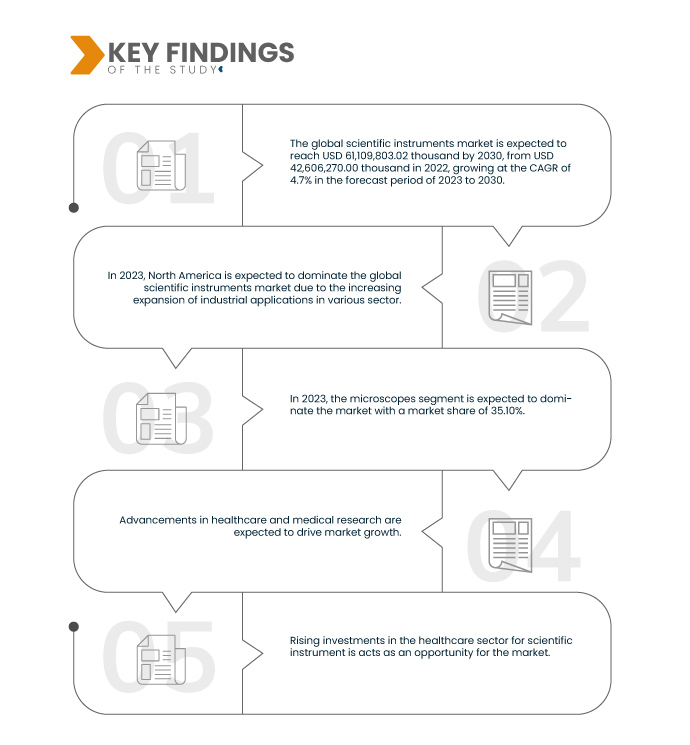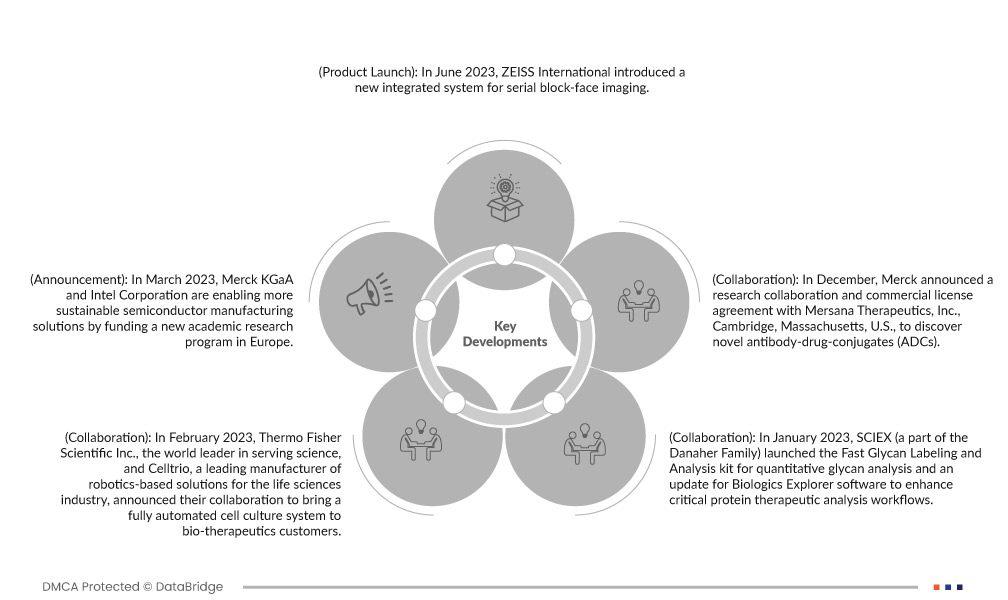Advancements in healthcare and medical research have significantly contributed to the growth of the scientific instruments market in several ways. These advancements create demand for sophisticated tools and technologies that enable researchers, clinicians, and healthcare professionals to conduct more accurate and comprehensive analyses. The move toward precision medicine, which tailors medical treatments to individual patients based on their genetic makeup and other factors, requires advanced diagnostic tools. Scientific instruments such as genetic sequencers, molecular analyzers, and biomarker detection systems are crucial for identifying genetic variations and other factors that influence individual responses to treatments.
Access Full Report @ https://www.databridgemarketresearch.com/reports/global-scientific-instruments-market
Genomic and proteomic research involves analyzing DNA, RNA, proteins, and other molecules to understand disease mechanisms and develop targeted therapies. High-throughput sequencing platforms, mass spectrometers, and other advanced instruments are essential for deciphering complex biological processes
Data Bridge Market Research analyses that the Global Scientific Instruments Market is expected to grow with a CAGR of 4.7% in the forecast period from 2023 to 2030, and is expected to reach USD 61,109,803.02 thousand by 2030.
Key Findings of the Study
Increasing Drug Development and Innovations
Drug development requires a deep understanding of molecular interactions, biological processes, and disease mechanisms. Scientific instruments offer researchers the tools to conduct intricate experiments, analyze complex data, and gain insights that are essential for developing new drugs and therapies. The process of identifying potential drug candidates involves screening large libraries of compounds for their biological activity. High-throughput screening instruments enable researchers to test thousands of compounds quickly and efficiently, accelerating the drug discovery process.
Report Scope and Market Segmentation
|
Report Metric
|
Details
|
|
Forecast Period
|
2023 to 2030
|
|
Base Year
|
2022
|
|
Historic Years
|
2021 (Customizable to 2015-2020)
|
|
Quantitative Units
|
Revenue in USD Thousand
|
|
Segments Covered
|
Product (Microscopes, Spectrometers, X-ray Diffraction, Thermal Analyzers, Optical Measurement Systems, and Others), Modality (Handheld, Benchtop, Portable, and Others), Application (Clinical and Research), End User (Hospitals, Laboratories, Healthcare Companies, Academic and Research Institutes, and Others), Distribution Channel (Direct Tender, Retail Sales, Online Sales, and Others)
|
|
Countries Covered
|
U.S., Canada, Mexico, Germany, France, U.K., Italy, Spain, Russia, Turkey, Belgium, Netherlands, Switzerland, Denmark, Norway, Sweden, Poland, Finland, Rest of Europe, Japan, China, South Korea, India, Australia, Singapore, Thailand, Malaysia, Indonesia, Philippines, Vietnam, New Zealand, Taiwan, Rest of Asia-Pacific, Brazil, Argentina, Rest of South America, South Africa, Saudi Arabia, U.A.E., Egypt, Israel, Oman, Qatar, Bahrain, and Rest of Middle East and Africa
|
|
Market Players Covered
|
Merck KGaA (Germany), DH Life Sciences, LLC. (U.S.), Thermo Fisher Scientific Inc. (U.S.), ZEISS International (Germany), Waters Corporation (U.S.), Bio-Rad Laboratories, Inc. (U.S.), Agilent Technologies, Inc. (U.S.), PerkinElmer Inc. (U.S.), Bruker (Germany), Thorlabs, Inc. (U.S.), Malvern Panalytical Ltd. (Germany), HORIBA, Ltd. (Japan), Promega Corporation (U.S.), EVIDENT (Japan), Anton Paar GmbH (Austria), Ocean Insight (U.S.), Rigaku Corporation (U.S.), Hitachi High-Tech Analytical Science (England), LABINDIA ANALYTICAL INSTRUMENTS PVT. LTD. (India), Panomex Inc. (India), and Nikon Instruments Inc. (Japan)
|
|
Data Points Covered in the Report
|
In addition to the insights on market scenarios such as market value, growth rate, segmentation, geographical coverage, and major players, the market reports curated by the Data Bridge Market Research also include depth expert analysis, patient epidemiology, pipeline analysis, pricing analysis, and regulatory framework.
|
Segment Analysis
The global scientific instruments market is segmented into five notable segments based on product, modality, application, end user, and distribution channel.
- On the basis of product, the market is segmented into microscopes, spectrometers, x-ray diffraction, thermal analyzers, optical measurement systems, and others.
In 2023, the microscopes segment is expected to dominate the global scientific instruments market
In 2023, the microscopes segment is expected to dominate the market with 35.10% market share due to rising research and development activities.
- On the basis of modality, the market is segmented into handheld, benchtop, portable, and others.
In 2023, the handheld segment is expected to dominate the global scientific instruments market
In 2023, the handheld segment is expected to dominate the market with 63.23% market share due to rising technological advancements.
- On the basis of application, the market is segmented into clinical and research. In 2023, the clinical segment is expected to dominate the market with 56.75% market share.
- On the basis of end user, the market is segmented into hospitals, laboratories, healthcare companies, academic and research institutes, and others. In 2023, the hospitals segment is expected to dominate the market with 44.59% market share.
- On the basis of distribution channel, the market is segmented into direct tender, retail sales, online sales, and others. In 2023, the direct tender segment is expected to dominate the market with 55.63% market share.
Major Players
Data Bridge Market Research recognizes the following companies as the market players in the market that include Merck KGaA (Germany), DH Life Sciences, LLC. (U.S.), Thermo Fisher Scientific Inc. (U.S.), ZEISS International (Germany), Waters Corporation (U.S.), among others.
Market Development
- In June 2023, ZEISS International introduced a new integrated system for serial block-face imaging. The newly introduced ZEISS Volutome is an in-chamber ultramicrotome for ZEISS field emission scanning electron microscopes (FE-SEM). It is designed to image the ultrastructure of biological, resin-embedded samples in 3D in life sciences. This has helped the company to strengthen its product portfolio.
- In March 2023, Merck KGaA and Intel Corporation are enabling more sustainable semiconductor manufacturing solutions by funding a new academic research program in Europe.
- In February 2023, Thermo Fisher Scientific Inc., the world leader in serving science, and Celltrio, a leading manufacturer of robotics-based solutions for the life sciences industry, announced their collaboration to bring a fully automated cell culture system to bio-therapeutics customers.
- In January 2023, SCIEX (a part of the Danaher Family) launched the Fast Glycan Labeling and Analysis kit for quantitative glycan analysis and an update for Biologics Explorer software to enhance critical protein therapeutic analysis workflows. With these new additions, SCIEX continues to expand its ability to support the characterization of complex and next-generation biopharmaceuticals in different parts of the drug development pipeline.
- In December 2022, Merck announced a research collaboration and commercial license agreement with Mersana Therapeutics, Inc., Cambridge, Massachusetts, USA, to discover novel antibody-drug-conjugates (ADCs).
Regional Analysis
Geographically, the countries covered in the market report are U.S., Canada, Mexico, Germany, France, U.K., Italy, Spain, Russia, Turkey, Belgium, Netherlands, Switzerland, Denmark, Norway, Sweden, Poland, Finland, Rest of Europe, Japan, China, South Korea, India, Australia, Singapore, Thailand, Malaysia, Indonesia, Philippines, Vietnam, New Zealand, Taiwan, Rest of Asia-Pacific, Brazil, Argentina, Rest of South America, South Africa, Saudi Arabia, U.A.E., Egypt, Israel, Oman, Qatar, Bahrain, and Rest of Middle East and Africa.
As per Data Bridge Market Research analysis:
North America is expected to dominate and is also the fastest-growing region in the global scientific instruments market
North America is expected to dominate the market due to the higher level of investments by various manufacturers and increasing technological advancements in the region. North America will continue to dominate the market in terms of market share and market revenue. It is estimated to be the fastest-growing region during the forecast period 2023-2030 due to the growing adoption of advanced technology and the launch of new products in this region.
For more detailed information about the global scientific instruments market report, click here – https://www.databridgemarketresearch.com/reports/global-scientific-instruments-market












